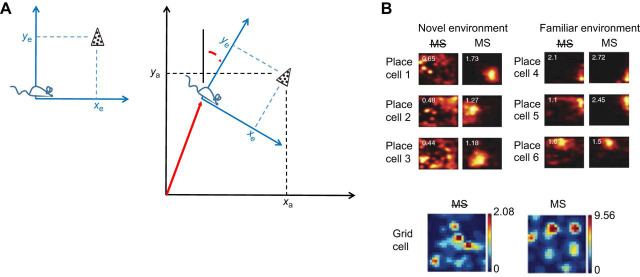Fig. 6.
Converging insights into the role of path integration in map building: cognitive models and neurophysiological data are broadly consistent with approaches to robot SLAM. (A) Behavioral studies suggest the existence of map-like cognitive representations in many species. In a novel environment, such a representation needs to be populated by salient environmental features. These features are egocentrically perceived (e.g. coordinates xe,ye of a visual landmark, left plot), but they eventually need to be charted relative to the stable allocentric reference frame adopted for the map (coordinates xa,ya, right plot). This can be achieved mathematically by a coordinate transformation (translation+rotation) based on parameters derived from path integration (red translation vector and rotation angle in red defining the animal's pose in the map frame, right plot). Albeit much simpler, this general model assigns a similar role to path integration in map-building as does the SLAM framework of Fig. 5. [See fig. 5.1 of Gallistel (1990) for more details and analysis extended to algebraic representations of curves and surfaces, reminiscent of the boundaries of an environment.] (B) One implication of this perspective is that the disruption of path integration or its outputs should lead to reduced spatial modulation of the firing fields of place cells in novel environments, but not necessarily in familiar ones, where self-localization can rely on previously charted landmarks (as in Fig. 4). Top: place fields from the same place cells are disrupted in a novel, large enclosure if the medial septum is inactivated (MS with strikethrough), but not when the platform is highly familiar (adapted from Wang et al., 2015). Bottom: when the medial septum is inactivated, grid cells lose their characteristically regular firing pattern, which may be sustained by path integration (adapted from Koenig et al., 2011).

